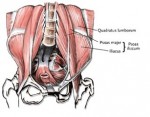
Edit:
This is an older article (almost a decade at the point of this edit) and is no longer in keeping with my belief system.
Pain is complex, and the following is not at all representative of that complexity.
Our sense of pain and dysfunction is highly influenced by biopsychosocial factors, and our own perceptions.
The reason I still keep this article up and others from a similar time are that I believe it’s important to be transparent about the fact that we in this industry are all fallible, and that there is no shame in admitting that you were previously speaking from a place of lesser knowledge.
The links between core “weakness” and “instability” and back pain are tenuous at best. When I wrote this my education had solidly adhered to the idea that a weak core and tight hip flexors were your recipe for back pain – they are not.
That being said, thank you, and I hope you enjoy a chuckle as you read 🙂
You’re at the gym doing your second set of squats, a personal trainer asks if they can offer you some advice… Engage your core.
Do you have any idea what they’re talking about? Do they?
In the 5 years I have been working with athletes, personal trainers, AT’s and RMT’s I have actually met very few who actually knew what the core was, much less how to make it work for you.
To most people (health care professionals included) the core is this vague sense of your abdominal muscles, and it’s important… but they don’t really know why.
What is it?
The term core actually refers to a series of muscles in your low back, abdominal area, pelvis and ribcage. For the purposes of this article I will stick to the internal core muscles (if you want to go by fascial connections to the core, almost any muscle in the trunk or upper legs could be considered a core augmenting muscle). Here I will list the muscles of the core and how they work to help in workouts and pain control.
Abdominal Diaphragm – Yes, your breathing muscle. This muscle attaches to your l umbar spine and the inside of your ribcage and acts as a sort of ceiling to the core itself.
umbar spine and the inside of your ribcage and acts as a sort of ceiling to the core itself.
Quadratus Lumborum – This short powerful back muscle attaches superiorly from your lower rib down inferiorly to the upper crest of your pelvis and medially to the sides of your lumbar vertebrae. This becomes a major part of the posterior wall of your core.
Psoas – 2 muscles on each side, the major and minor. These hip flexors run from the front of the lumbar vertebrae, and run down to attach to the upper thigh bone. They act as part of the posterior wall of the core adding congruency to the wall.
Transverse Abdominus – A muscle that runs laterally from the back around the side of the abdominal cavity and attaches into the other abdominal muscles in the front. It acts like a lateral wall to the sides of the core.
Obliques – External and Internal obliques act to add congruency to the lateral core again, and generate force from the ribs down the the front of the pelvis, and from the front of the ribs down to the lateral side of the pelvis.
Rectus Abdominus – Everybody’s favourite abdominal muscle (the 6-pack!) and it’s surprisingly overlooked as a core muscle. Everybody trains the upper portion (the part you see as your 6-pack) and neglects the lower portion as it attaches down to the front of the pelvis on the pubic bones. As you can guess this muscle makes the front of the core and pulls the ribcage towards the pelvis.
Pelvic Floor muscles – This series of muscles by far the most overlooked part of the core, and by far the most important. The pelvic floor muscles literally act as a floor to the core as well as helping stabilize the pelvis and the joints therein. If these muscles are firing when they need to the pelvis will be properly supported and less dysfunction will be experienced.
How do they work?
When the abdominal and back muscles of the core are engaged (tensing), they form a sort of circular wall going around from the spine to the navel on each side, and from the pelvis to the ribs on the front, sides and back (picture it like the wall of a popcan). This will act to contain the abdominal organs (like a back support belt, but more complete). The Diaphragm on the top acts like the lid of the pop can pressing down on the abdominal organs, and the pelvic floor engages last to push up on the abdominal and pelvic organs. This compression in all 3 plains acts to squeeze the contents of the abdominal pelvic cavity, which pushes out on the spine and serves to support the lumbar spine (creating a sort of fluid ball within the abdomino-pelvic cavity. This also reduces the fluid like dynamics of the contents of the abdomen and makes it act more like a solid, so force is transferred up from the legs to the ribs or vice versa through the pelvis and abdomen much more quickly and smoothly.
What does this mean?
By training your core, you can decrease the frequency and intensity of back pain, and for athletes you can increase your performance. More stability means less injuries, and the increased efficiency essentially means more power and balance.
Be sure to follow my video series on youtube under haddowmassagetherapy for more information on the core muscles, how to use them and how to train them.


